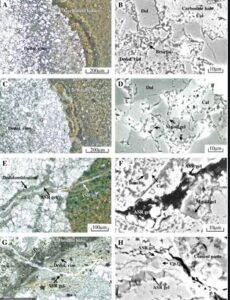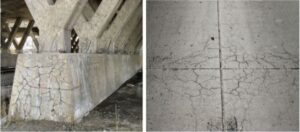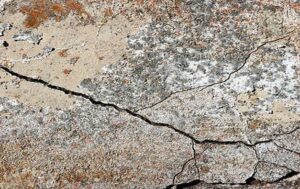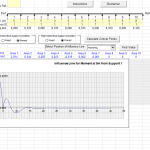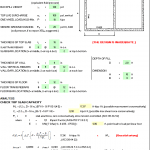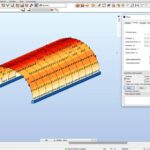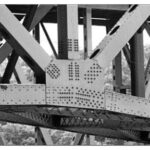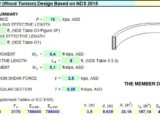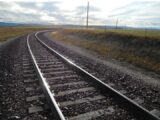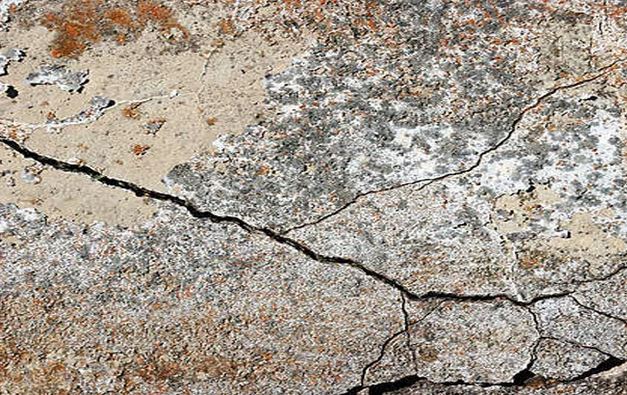
Potential Causes of Concrete Failures
12 May 2021Table of Contents
Potential Causes of Concrete Failures
The list of potential causes of concrete failures is a long one. A few examples include chemical reactions, shrinkage, weathering, and erosion. Many other potential causes exist, and we will explore them individually. Understanding the causes of concrete structure dam-age is an important element in the business of rehab and repair work.
1. UNINTENTIONAL LOADS
Unintentional loads are not common, which is why they are accidental. When an earth-quake occurs and affects concrete structures, that action is considered to be an accidental loading. This type of damage is generally short in duration and few and far between in occurrences.
Visual inspection will likely find spalling or cracking when accidental loadings occur. How is this type of damage stopped? Generally speaking, the damage cannot be prevented, because the causes are unexpected and difficult to anticipate. For example, an engineer is not expecting a ship to hit a piling for a bridge, but it happens. The only defense is to build with as much caution and anticipation as possible.
2. CHEMICAL REACTIONS
Concrete damage can occur when chemical reactions are present. It is surprising how little it takes for a chemical attack on concrete to do serious structural damage.
Examples of chemical reactions and how they affect concrete:
a- Acidic Reactions
Most people know that acid can have serious reactions with a number of materials, and concrete is no exception. When acid attacks concrete, it concentrates on its products of hydration. For example, calcium silicate hydrate can be adversely affected by exposure to acid.
Sulfuric acid works to weaken concrete and if it is able to reach the steel reinforcing members, the steel can be compromised. All of this contributes to a failing concrete structure.
Visual inspections may reveal a loss of cement paste and aggregate from the matrix. Cracking, spalling, and discoloration can be expected when acid deteriorates steel reinforcements, and laboratory analysis may be needed to identify the type of chemical causing the damage.
b- Aggressive Water
Aggressive water is water with a low concentration of dissolved minerals. Soft water is considered aggressive water and it will leach calcium from cement paste or aggregates. This is not common in the United States. When this type of attack occurs, however, it is a slow process. The danger is greater in flowing waters, because a fresh supply of aggressive water continually comes into contact with the concrete.
If you conduct a visual inspection and find rough concrete where the paste has been leached away, it could be an aggressive-water defect. Water can be tested to determine if water quality is such that it may be responsible for damage. When testing indicates that water may create problems prior to construction, a non-Portland-cement-based coating can be applied to the exposed concrete structures.
c- Alkali-Carbonate Rock Reaction
Alkali-carbonate rock reaction can result in damage to concrete, but it can also be beneficial. Our focus is on the destructive side of this action, which occurs when impure dolomitic aggregates exist. When this type of damage occurs, there is usually map or pattern cracking and the concrete can appear to be swelling.
Alkali-carbonate rock reaction differs from alkali-silica reaction because there is a lack of silica gel exudations at cracks. Petrographic examination can be used to confirm the presence of alkali-carbonate rock reaction. To prevent this type of problem, contractors should avoid using aggregates that are, or are suspected to be, reactive.
d- Alkali-Silica Reaction
An alkali-silica reaction can occur when aggregates containing silica that is soluble in highly alkaline solutions may react to form a solid, non expansive, calcium-alkali-silica complex or an alkali-silica complex that can absorb considerable amounts of water and expand. This can be disruptive to concrete.
Alkali-silica reaction in concrete
Concrete that shows map or pattern cracking and a general appearance of swelling could be a result of an alkali-silica reaction. This can be avoided by using concrete that contains less than 0.60% alkali.
e- Various Chemical Attacks
Concrete is fairly resistant to chemical attack. For a substantial chemical attack to have degrading effects of a measurable nature, a high concentration of chemical is required. Solid dry chemicals are rarely a risk to concrete. Chemicals that are circulated in contact with concrete do the most damage.
When concrete is subjected to aggressive solutions under positive differential pressure, the concrete is particularly vulnerable. The pressure can force aggressive solutions into the matrix. Any concentration of salt can create problems for concrete structures. Temperature plays a role in concrete destruction with some chemical attacks. Dense concrete that has a low water–cement ratio provides the greatest resistance.
The application of an approved coating is another potential option for avoiding various chemical attacks.
f- Sulfate Situations
A sulfate attack on concrete can occur from naturally occurring sulfates of sodium, potassium, calcium, or magnesium. These elements can be found in soil or in ground water. Sulfate ions in solution will attack concrete. Free calcium hydroxide reacts with sulfate to form calcium sulfate, also known as gypsum. When gypsum combines with hydrated calcium aluminate it forms calcium sulfoaluminate.
Either reaction can result in an increase in volume. Additionally, a purely physical phenomenon occurs where a growth of crystals of sulfate salts disrupts the concrete. Map and pattern cracking are signs of a sulfate attack. General disintegration of concrete is also a signal of the occurrence.Sulfate attacks can be prevented with the use of a dense, high-quality concrete that has a low water–cement ratio. A Type V or Type II cement is a good choice.
If pozzolan is used, a laboratory evaluation should be done to establish the expected improvement in performance.
g- Poor Workmanship
Poor workmanship accounts for a number of concrete issues. It is simple enough to follow proper procedures, but there are always times when good practices are not employed. The solution to poor workmanship is to prevent it. This is much easier said than done. All sorts of problems can occur when quality workmanship is not assured and some of the key causes for these problems are as noted below:
- Adding too much water to concrete mixtures
- Poor alignment of formwork
- Improper consolidation
- Improper curing
- Improper location and installation of reinforcing steel members
- Movement of formwork
- Premature removal of shores or reshores
- Settling of concrete
- Settling of subgrade
- Vibration of freshly placed concrete
- Adding water to the surface of fresh concrete
- Miscalculating the timing for finishing concrete
- Adding a layer of concrete to an existing surface
- Use of a tamper
- Jointing
3. CORROSION
Corrosion of steel reinforcing members is a common cause of damage to concrete. Rust staining will often be present during a visual inspection if corrosion is at work. Cracks in concrete can tell a story. If they are running in straight lines, as parallel lines at uniform intervals that correspond with the spacing of steel reinforcement materials, corrosion is prob-ably at the root of the problem. In time, spalling will occur. Eventually, the reinforcing mate-rial will become exposed to a visual inspection.
Techniques for stopping, or controlling, corrosion include the use of concrete with low permeability. In addition, good workmanship is needed. Some tips to follow include:
- Use as low a concrete slump as
- Cure the concrete
- Provide adequate concrete cover over reinforcing
- Provide suitable
- Limit chlorides in the concrete
- Pay special attention to any protrusions, such as bolts and
4.FREEZING AND THAWING
Freezing and thawing during the curing of concrete is a serious concern. Each time the concrete freezes, it expands. Hydraulic structures are especially vulnerable to this type of damage. Fluctuating water levels and under-spraying conditions increase the risk. Using deicing chemicals can accelerate damage to concrete with resultant pitting and scaling. Core samples will probably be needed to assess damage.
Prevention is the best cure. Provide adequate drainage, where possible, and work with low water–cement ratio concrete. Use adequate entrained air to provide suitable air-void systems in the concrete. Select aggregates best suited for the application, and make sure that concrete cures properly.
5. SETTLEMENT AND MOVEMENT
Settlement and movement can be the result of differential movement or subsidence. Concrete is rigid and cannot stand much differential movement. When it occurs, stress cracks and spall are likely to occur. Subsidence causes entire structures or single elements of entire structures to move. If subsidence is occurring, the concern is not cracking or spalling; the big risk is stability against overturning or sliding.
A failure via subsidence is generally related to a faulty foundation. Long-term consolidations, new loading conditions, and related faults are contributors to subsidence. Geotechnical investigations are often needed when subsidence is evident.
Cracking, spalling, misaligned members, and water leakage are all evidence of structure movement. Specialists are normally needed for these types of investigations.
6. SHRINKAGE
Shrinkage is caused when concrete has a deficient moisture content. It can occur while the concrete is setting or after it is set. When this condition happens during setting, it is called plastic shrinkage; drying shrinkage happens after concrete has set.
Plastic shrinkage is associated with bleeding, which is the appearance of moisture on the surface of concrete. This is usually caused by the settling of heavier components in a mixture. Bleed water typically evaporates slowly from the surface of concrete.
When evaporation occurs faster than water is supplied to the surface by bleeding, high-tensile stresses can develop. This stress can lead to cracks on the concrete surface.Cracks caused by plastic shrinkage usually occur within a few hours of concrete placement.
These cracks are normally isolated and tend to be wide and shallow. Pattern cracks are not generally caused by plastic shrinkage.
Weather conditions contribute to plastic shrinkage. If the conditions are expected to be conducive to plastic shrinkage, protect the pour site with windbreaks, tarps, and similar arrangements to prevent excessive evaporation. In the event that early cracks are discovered, revibration and refinishing can solve the immediate problem. Drying shrinkage is a long-term change in volume of concrete caused by the loss of moisture.
A combination of this shrinkage and restraints will cause tensile stresses and lead to cracking. The cracks will be fine and the absence of any indication of movement will exist. The cracks are typically shallow and only a few inches apart. Look for a blocky pattern to the cracks.
They can be confused with thermally induced deep cracking, which occurs when dimensional change is restrained in newly placed concrete by rigid foundations or by old lifts of concrete.
To reduce drying shrinkage, try the following precautions:
- Use less water in
- Use larger aggregate to minimize paste
- Use a low temperature to cure concrete
- Dampen the subgrade and the concrete
- Dampen aggregate if it is dry and
- Provide adequate
- Provide adequate contraction joints
7. FLUCTUATIONS IN TEMPERATURE
Fluctuations in temperature can affect shrinkage. The heat of hydration of cement in large placements can present problems. Climatic conditions involving heat also affect concrete; for example, fire damage, while rare, can also contribute to problems associated with excessive heat.

